Forward into the past
Museum of Comparative Zoology looks to the future
At Harvard’s Museum of Comparative Zoology (MCZ), there’s a New Guinea butterfly whose collector was himself captured and eaten by cannibals. There’s a 150-million-year-old kronosaurus, whose toothy skeleton covers an entire exhibit wall. There’s a now-extinct black mamo, a bird with a long curved beak caught on explorer James Cook’s 1778 voyage to Hawaii, which he “discovered” for Europeans.
The now-extinct species in the museum’s display cases, drawers, and cabinets include a dodo and a great auk, a passenger pigeon and ivory-billed woodpeckers, a Steller’s sea cow and a Tasmanian tiger. There are many thousands of present-day creatures too, including giant whales, giraffes, and gorillas.
The museum, which marks its 150th anniversary this year, is full of musty, dusty specimens, about 21 million and counting.
But if you thought the MCZ is frozen in time, you’d be dead wrong. The digital and the DNA revolutions have arrived in full force, and the museum is roaring headlong into the Internet age.
Museum staff members already have loaded almost 700,000 digital records onto the Web, where they are accessible to researchers and students alike, and officials hope to complete the process within five years. DNA testing, which was unknown when many of the specimens were gathered decades ago, has become a master key in tracing animals’ lineage and evolution. Even the oldest samples generally yield telltale DNA.
In short, the museum is stuffed full of specimens, from basement to attic — where a blue whale resides — but it has never been about the specimens, as such. It was, and is, about the knowledge that they contain.
MCZ celebrates 150 years Photos by Stephanie Mitchell/Harvard Staff Photographer
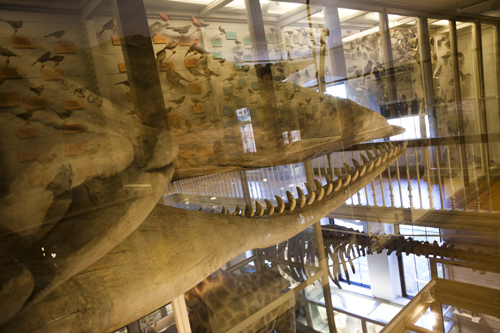
A whale of a time
Full-size whale skeletons hang from the ceiling of the renovated Hall of Mammals inside Harvard’s Museum of Comparative Zoology (MCZ).
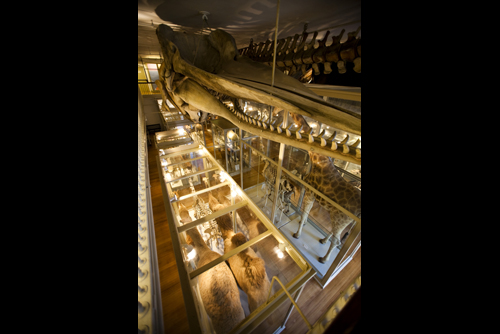
A whale of a time
Full-size whale skeletons hang from the ceiling of the renovated Hall of Mammals inside Harvard’s Museum of Comparative Zoology (MCZ).
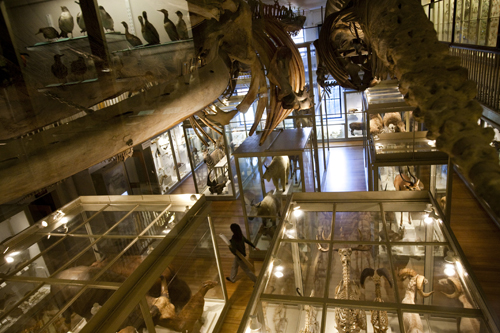
Hall of Mammals
Inside the Hall of Mammals, animal skeletons live alongside their furred, lifelike companions.
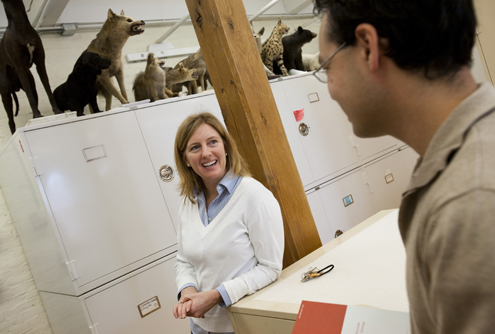
Mammal people
Hopi Hoekstra, Loeb Associate Professor of the Natural Sciences and curator of mammology, and Mark Omura, curatorial assistant, talk amidst the MCZ’s mammal collection.
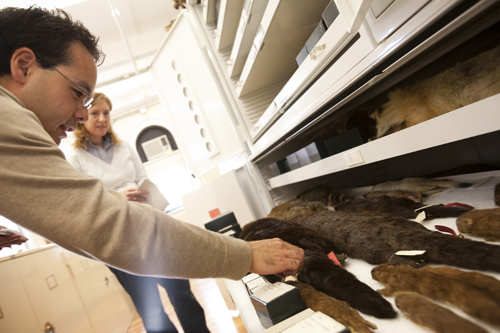
Touchy feely
Omura and Hoekstra examine pelts that, as “type specimens,” help define the species for science.
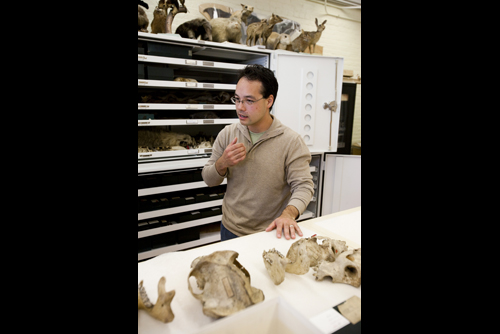
Animal applause
With an animal audience behind him, Omura discusses specimens in the MCZ’s mammal collection.
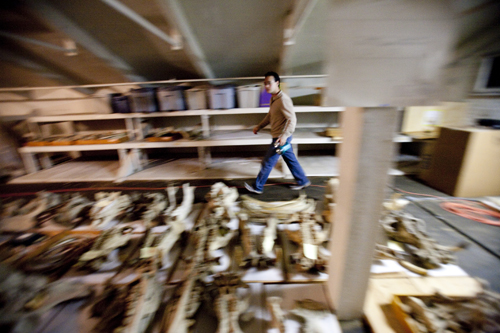
Toys in the attic
Omura walks among treasures stored in the MCZ’s “attic.”
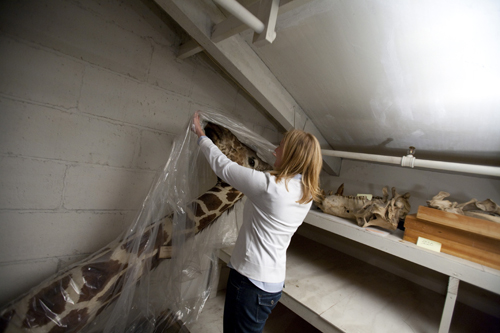
In the eye of the giraffe
In the “attic,” Hoekstra uncovers a giraffe whose neck is as tall as she.
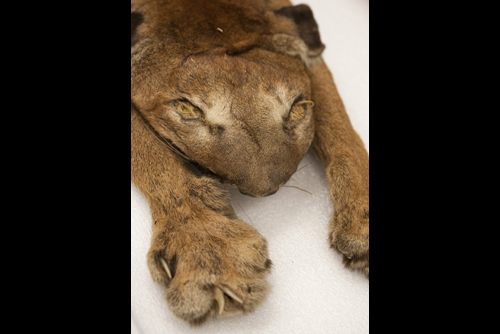
Brown panther
Skin and fur, claws and whiskers of a panther — one of the MCZ’s valued “type specimens.”
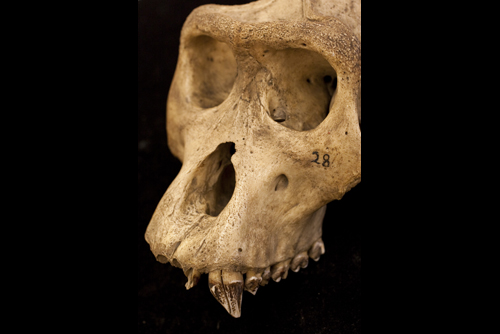
Gorillas in the mist
Against a pitch background, this gorilla skull can really shine.
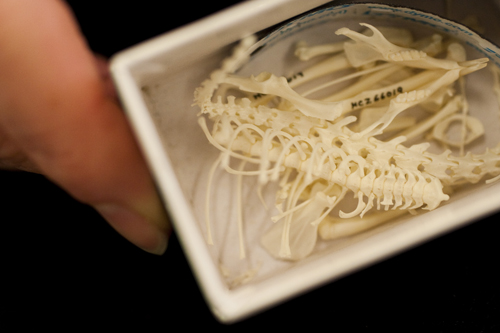
Box of bones
These deer mouse bones were collected by Hoekstra, who is studying the impact of natural selection on deer mice fur color.
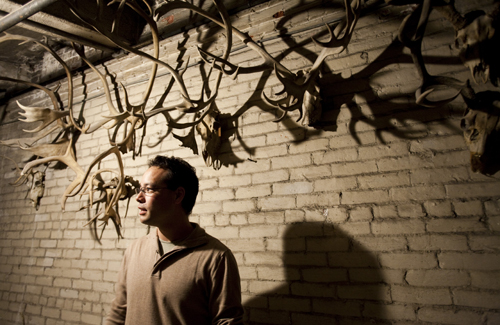
Self-portrait, with antlers
Suspended antlers frame Omura inside another of the MCZ’s unique collections.
The beetles, bats, and other beasts sitting in drawers, cabinets, and display cases constitute both a vast library of life and a scientific time machine. They tell scientists who are savvy enough to ask not just the details of a specific bird or lizard or snail, but about where it lived and when.
In this anniversary year, the MCZ is allowing itself a reprieve from the frenetic pace of collecting, educating, and researching to remember its past. Yet in examining the intent of its founder, Louis Agassiz, it also finds itself looking at its future.
MCZ Director James Hanken said Agassiz’s vision of the museum as a place for education and research on the origin, history, and diversity of life endures today. And though the traditional collections remain, that search for knowledge is executed increasingly through modern methods. There are several major drives under way to digitize the museum’s collections, beginning with the so-called metadata, the written details accompanying a specimen, where it was collected, when, and by whom.
Other information is being added as it becomes available, such as digital images, X-rays, and field notes. The digitized, online database for the ichthyology collection, for example, shows 23 specimens of piranha, the famed flesh-eating fish that haunts South American waterways. The records show where, when, and by whom the fish were collected, and that two species, despite the piranha’s fearsome reputation, are fruit eaters.
Examining specimens with a mouse click
Another effort, begun last summer, raises the bar on the type of information available to far-flung scholars over the Internet. A program called Aves 3D uses advanced laser scanners to create three-dimensional digital images of the museum’s 12,000 bird skeletons, which include such gems as a complete skeleton of the extinct dodo. The effort will result in an online database available to scholars and schoolchildren alike that will allow those interested not only to see the bird bones, but to measure and manipulate them in three dimensions.
Hanken reeled off a list of other digitization efforts, among them HerpNet for reptiles and amphibians, FishNet for fish, ORNIS for birds, and MaNIS for mammals. There are others, each with a different wrinkle in the nature and type of information available.
Hanken said the museum’s digital strides have already resulted in increases in the number of scholars using the collections and decreases in the number of requests for in-person visits or for specimens to be mailed to researchers’ home institutions. That has the twin benefit, Hanken said, of increasing the collection’s usefulness while decreasing wear and tear on the specimens.
“We’re basically going to digitize everything associated with the specimens. Anyone, anywhere can pull up information anytime for free,” Hanken said. “We’re sitting on a gold mine of information. The trick is to get this stuff out there. Many scientists don’t know what we have.”
The digitization effort across the MCZ has already generated 687,210 records, encompassing more than a million specimens. Though funding may prove a limiting factor, Hanken said he expects the process to be completed in the next five years.
Then there are the myriad cutting-edge uses for DNA, that revelatory foundation of modern science, which is in every MCZ specimen. It is held in death as it was in life, in tissues preserved in various ways, soaked in alcohol, dried, or held in feathers or fur.
In recent years, investigating a creature’s DNA has become as important as measuring its beak size or skull dimensions in science’s efforts to understand a creature and how it interacts with its environment. Hanken and the MCZ’s faculty curators say that the rising prominence of DNA in scientific inquiry has made the museum’s specimens more relevant, not less.
Hopi Hoekstra, the MCZ’s curator of mammals and Loeb Associate Professor of the Natural Sciences, said that for virtually every mammal specimen collected a bit of tissue is also taken and held frozen as a DNA specimen. That practice is true for other collections as well, Hanken said, and the museum plans to create a holding area for deep-frozen tissues as part of a centralized collection.
“People routinely collect materials for genetic analysis,” Hanken said. “It’ll hold hundreds of thousands of specimens.”
While tissues collected specifically for DNA analysis are valuable, Hoekstra said one strength of the MCZ collections is that for many specimens, even the older ones, usable DNA can still be extracted.
Hoekstra’s own research, which has added 3,000 specimens to the mammal collection in the past two years, examines natural selection’s impact on the coat color of deer mice.
“A lot of our work depends on collections from 100 years ago, so we can compare temporally,” Hoekstra said. “We can … get DNA out of ancient specimens. We can look not only at differences in color but also at genetic change through time. Some older specimens have been skinned, dried, and dipped in benzene, and we can still get useful DNA out of them.”
Hoekstra and Hanken said that with an extinction crisis under way amid a warming world, museum collections are more important than ever in helping to unravel the changes taking place.
“If you think about global climate change, we can document changes in the ranges of animals. Things are being found in places they never have before and are lost in places where they once were,” Hoekstra said.
So much for the idea that the museum is a musty home for stuffed animals.
A collection born amid controversy
The MCZ was founded in 1859 by famed Swiss scientist Louis Agassiz, who was known for discovering the Ice Ages. Agassiz came to Harvard intent on starting a museum that would rival the great institutions of Europe. Today, however, Agassiz is as much remembered for being on the wrong side of the evolution debate as he is for his work at the MCZ or for his earlier scientific findings.
His efforts not only established an enduring scientific institution, but also drove collecting efforts that enriched it. One expedition to the Amazon, during which Agassiz hoped to find evidence against Charles Darwin’s theories of evolution, gathered specimens representing 2,200 species, an astounding 2,000 of which were new to science.
Agassiz’s son, Alexander, furthered his father’s efforts. He became the museum’s second and longest-serving director and used his great personal wealth to bring his father’s museum vision to fruition.
There have been nine directors since the museum’s founding, including prominent scientists such as evolutionary biologist Ernst Mayr, who led the institution from 1961 to 1970. In addition to the museum’s directors, research is conducted by faculty curators of 12 departments and the Concord Field Station, covering subjects and collections from entomology to vertebrate paleontology. These curators also hold appointments in Harvard’s Department of Organismic and Evolutionary Biology.
Presenting a popular public face
Though research and teaching are the MCZ’s main reasons for being, its public galleries have been an important component of its educational mission since its founding.
In 1998, the MCZ joined with two other Harvard institutions, the Harvard University Herbaria, owner of the famed Glass Flowers collection, and the Mineralogical and Geological Museum to form the Harvard Museum of Natural History (HMNH). The HMNH manages the three institutions’ public programs, employing museum professionals who collaborate with curators to design exhibits, arrange lectures, and put together weekend classes and workshops.
The galleries represent a mix of historical and modern museum sensibilities. New exhibits on color in nature; on the broad array of insects, crustaceans, and other arthropods; and on evolution employ the latest in museum-presentation techniques, with eye-catching, interactive displays, explanatory placards, and sometimes dazzling arrangements of specimens.
But the museum also contains galleries as Agassiz intended them. Agassiz was widely praised after the MCZ’s opening for his arrangement of specimens according to geographic location, something that was not done at other museums and that allowed visitors to gain a better understanding of the natural context in which creatures were found. To this day, several galleries remain organized according to those guidelines, presenting animals from Africa, South America, and other locations.
To celebrate its anniversary, the museum renovated one of its gems, the Great Hall of Mammals. The two-story room, surrounded by a gallery level holding more exhibits, is the last survivor of the original halls that filled the museum building when it opened. The others became victims to the space squeeze that has been a constant at the museum, their galleries floored over, and their space divided up to other purposes.
Soaring and bright, the Mammal Hall now holds a full-sized giraffe, camels, and other large mammals enclosed in glass cases, presented today as they were when the museum opened. Hanging from the rafters — at eye level from the gallery — are large skeletons of a sperm whale, a fin whale, and a right whale. The renovation saw the floors refinished, the walls painted, and the exhibits cleaned and rearranged, but the effort kept the hall true to its original grandeur.
“The idea was to very much retain its Victorian look. That’s one of the [unique] things of this museum, it’s a museum of museums,” Hoekstra said.
Harvard’s “museum of museums” is alive and well, at least from the visitors’ standpoint, with their numbers increasing, approaching 200,000 last year.
“We’re one of the University’s best ‘front doors,’ ” Hanken said.
Hanken believes that the museum’s most valuable collections are its holotypes, the first members of a species to be collected and named. These sample specimens are taken and kept in museums as examples of new species, providing critical reference points for future biologists working on them. The MCZ, Hanken said, has tens of thousands of type specimens, including the gorilla, the wolf, the Florida panther, and the fox.
With aging specimens providing massive amounts of fresh knowledge, at the MCZ, the past is prologue.




